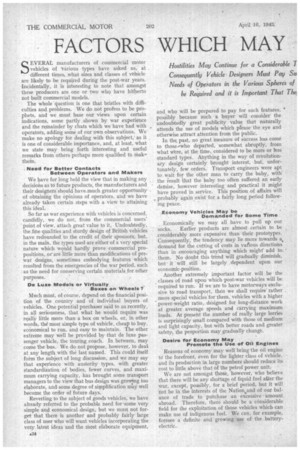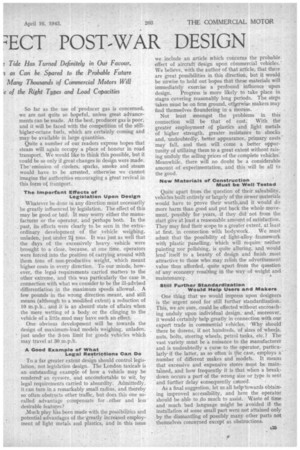FACTORS WHICH MAY ECT POST-WAR DESIGN
Page 26

Page 27

If you've noticed an error in this article please click here to report it so we can fix it.
Hostilities May Continue for a Considerable T Consequently Vehicle Designers Must Pay Su, Needs of Operators in the Various Sphere's of be Required and it is Important That The., Tide Has Turned Definitely in Our Favour, I as Can be Spared to the Probable Future Many Thousands of Commercial Motors Will e of the Right Types and Load Capacities SEVERAL manufacturers of commercial motor vehicles of various types have asked us, at different times, what sizes and classes of vehicle are likely to be required during the post-war years. Incidentally, it is interesting to note that amongst these producers are one or two who have hitherto not built commercial models.
The whole question is one that bristles with difficulties and problems. We do not profess to be prophets, and we must base our views upon certain indications, some partly shown by war experience and the remainder by chats which we have had with operators, adding some of our own observations. We make no apology for dealing with this subject,' as it is one of considerable importance, and, at least, what we state may bring forth interesting and useful remarks from others perhaps more qualified to mak-. them.
Need for Better Contacts . Between Operators and Makers We have for long held the view that in making any decisions as to future products, the manufacturers and their designers should haveanuch greater opportunity of obtaining the opinions of operators, and we have already taken certain steps with a view to attaining this ideal.
So far as war experience with vehicles is concerned, candidly, we do not, from the commercial users' point of view, attach great value to it, Undoubtedly, the fine qualities and sturdy design of British vehicles have redounded to the credit of their sponsors, but, in the main, the types used are either of a very special nature which w9uld hardly prove commercial propositions, or are little more than modifications of prewar designs, sometimes embodying features which resulted from the emergencies of the war period, such as the need for conserving certain materials for other purposes.
De Luxe Models or Virtually .
Boxes on Wheels?
Much must, of course, depend on the financial position of the country and of individual buyers of vehicles. One potential purchaser said to us recently, in all seriousness, that what he would require was really little more than a box on wheels, or, in other words, the most simple type of vehicle, cheap to buy, economical to run, and easy to maintain. The other extreme may well be provided by that de luxe passenger vehicle, the touring coach. In between, may come the bus. We do not propose, however, to deal at any length with the last named. This could itself form the subject of long discussion, and we may say that experience with austerity types, with greater standardization of bodies, fewer curves, and maximum carrying capacity, has brought some transport managers to the view that bus design was growing too elaborate, and some degree of simplification may well become the order of future days.
Reverting to the subject of goods vehicles, we have already referred to the probable need for some very simple and economical design, but we must not forget. that there is another and probably fairly large class of user who will want vehicles incorporating the very. latest ideas and the Most elaborate equipment, and who will be prepared to pay for such features, possibly because such a buyer will consider the undoubtedly great publicity value that naturally attends the use of models which please the eye and otherwise attract attention from the public.
In the past, no great measure of success has come to those.-who departed, somewhat abruptly, from what were, at the time, considered to be more or less standard types. Anything in the way of revolutionary design certainly brought interest, but, unfortunately, few orders. Transport engineers were apt to wait for the other man to carry the baby, with the fesult that the baby too often suffered an early detnise; however interesting and practical it might have proved in service. This position of affairs will t. probably again exist for a fairly long period following peace.
Economy Vehicles May be Demanded for Some Time Economically we may all have to pull up our socks. Earlier products are almost certain to be considerably more expensive than their prototypes. Consequently, the tendency may lie more towards a4 demand for the cutting Of costs in various directions than in enconraging anything which might' add to them. No doubt this trend will gradually diminish, but it 'will still be largely dependent upon our economic, position. Another extremely important factor will be the classes of road upon which -post-war vehicles will be required to run. If we are to have motorways exclusive to road transport, thin we shall require' rather more special vehicles for them, vehicles with a higher power-weight ratio,. designed for long-distance work at greater average speeds and carrying maximum loads. At present the number of really large lorries is surprisingly small compared with those of medium and light capacity, but with better roads and greater safety, the proportion may gradually change.
Desire for Economy May
Promote the Use of Oil .Engines Reasons of economy may well bring the oil engine td the forefront, even for the lighter class of vehicle, and its production in large numbers should reduce its cost to little above that of the petrol power unit.
We are not amongst those, however, who believe that there will be any shortage of liquid fuel atter the war, except, possibly, for a brief period, but it will riot be in the interests of the Nationeand of our balance of trade to purchase an excessive amount abroad. Therefore, there should be a considerable field for the exploitation of those vehicles which can make use of indigenous fuel. We can, for example, foresee a definite and growing use of the batteryelectric.. So far as the use of 'producer gas is concerned, we are not quite so hopeful, unless great advancements can be made. At the best, producer gas is poor, and it will be faced with the competition of the stillhigher-octane fuels, which are certainly coming and may be available in large quantities.
Quite a number of our readers express hopes that steam will again occupy a place of honour in road transport. We would like to think this possible, but it could be so only if great changes in design were made. The 'emission of cinders,' sparks, smoke and steam would have to be arrested, otherwise we cannot imagine the authorities encouraging a great revival in this form of transport.
The Imporfarit Effects of
Legislation Upon Design Whatever be done in any direction must necessarily be greatly influenced by legislation. The effect of this may be good or bad. It may worry either the manufacturer or the operator, and perhaps both. In the . past, its effects were clearly to be seen in the extraordinary development of the ...vehicle weighing, unladen, just under 2i tons. It was just as well that the days of the excessively heavy vehicle were brought to a close, because, at one time, operators were forced into the position of. carrying around with them tons of non-productive weight, which meant higher costs in every direction. To our minds, however, the legal requirements carried matters to the other extreme, and this was particularly the case in connection with what we consider to be the ill-advised differentiation in the Maximum speeds allowed. A few pounds in the wrong direction meant, and still means (although to a modified extent) a reduction of 10 m.p.h., and it is an absurd state of affairs when the mere wetting of a body or the clinging to the vehicle, of a little mudmay have such an effect.
One obvious development will be towards the design of maximum-load models weighing, unladen, just under the 3-tan limit for goods vehicles which may travel at 30 m.p.h.
A Good Example of What Legal Restrictions Can Do
To a far greater extent design should control legislation, not legislation design. The London-taxicab is an outstanding example of how a vehicle may be rendered' an eyesore, and unccimfortable to wit, by legal requirements carried to absurdity. Admittedly, it can turn in a remarkably small radius, and thereby so often obstructs other traffic, but does this one so-; called advantage compensate for . other 'and less desirable features?
Much play has been made with the possibilities and potential advantages.of the'greatly increased employment of light metals and plastics, and in this issue we include an article which concerns the probable Effect of aircraft design upon cOmmercial We believe, with the author of that article, that there are great possibilities in this direction, but it would be unwise to hold out hopes that these materials will immediately exercise a profound influence upon design. Progress is more likely to take place in stages covering reasonably long periods. The steps taken must be on firm ground, otirrwise makers may find themselves floundering in a morass.
Not least amongst the problems in this connection will be that of cost. With the greater employment of plastics and light metals of higher strength, greater resistance to shocks and, undoubtedly, better appearance, primary costs" may fall, and then Will come a better opportunity of utilizing them to a great extent without raising unduly the selling prices of the complete vehicles. Meanwhile, there will no doubt be a considerable amount of experimentation, and this will be all to the good.
New Materials of Construction Must be Well Tested
Quite apart from the question of their saleability, vehicles built entirely or largely of the newer materials would have to prove their worth,and it would do more harm than good and put back the whole movement, possibly for years, if they did not from the start give at least a reasonable amOunt of satisfaction. They may find their scope to a greater extent, at least at first, in connection with bodywork. We must admit that the possibility of light-alloy framework with plastic panelling, Which will require neither painting nor polishing, is quite alluring, and would lend itself to a beauty of design and finish most attractive to those who may relish the advertisement value thus afforded, quite apart from the question of any economy resulting in the way of weight and maintenance.
Still Further Standardization Would Help Users and Makers
One thing that we would impress upon designers is the urgent need for still further standardization. This, we are sure, could be effected without encroaching unduly upon individual design, and moreover, it would certainly help greatly in connection with our export trade in commercial vehicles. 'Why Should there be dozens, if not hundreds, of sizes of wheeJs, nuts, bolts, steering wheels, petrol tanks, etc.? The vast variety must be a nuisance to the manufacturer and is undoubtedly a curse to the operator, particularly if the latter, as so often is the case, employs a' number of different makes and models. It means that excessive and expensive stores must be maindined,. and how frequently it is that when a breakdown occurs a part of the wrong size or type is sent and. further delay eonsequently caused.
As a final suggestion, let us all help-towards obtaining improved accessibility, and here the operator should be able to clo much to assist. Waste of time and much bad language might be avoided if the installation of some small part were not attained only by the dismantling of possibly many other parts not themselves concerned except as obstructions.




















































